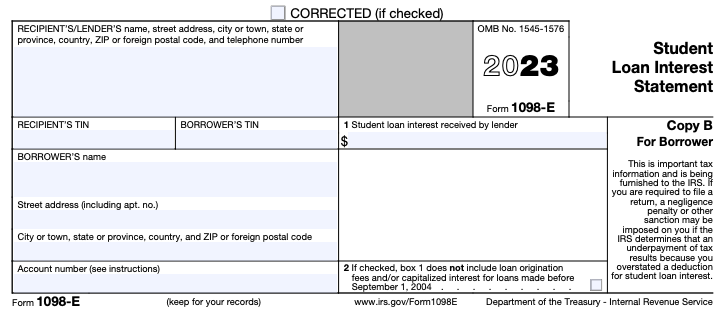
The 1098-E form is what you receive for tax season if you paid more than $600 in student loan interest last year.
People receiving their 1098-E Student Loan Interest Statement can qualify to deduct student loan interest. If you have significant student loan debt, this could yield up to a few hundred dollars in savings for you.
Today, we break down what the 1098-E is, and how it impacts your taxes so that you can potentially claim the student loan interest deduction.
Who Qualifies To Take The Student Loan Interest Deduction?
To take the student loan interest deduction, you must pay at least $600 in student loan interest. You can only deduct up to a maximum of $2,500 in interest paid.
The student loan interest deduction is an adjustment of your gross income. So if you paid $2,500 in student loan interest, and you earned $60,000, you’ll only pay taxes on $57,500.
For the purposes of the deduction, it doesn’t matter whether your loans are federal loans or private student loans. Both qualify for the deduction.
The student loan interest deduction goes to the person who is legally required to pay the student loans. That means, if your parents took out loans for you, they get the deduction. This is even true if you make the payments for the loans.
Married borrowers must opt to file taxes as married filing jointly if they want to qualify for the deduction.
The student loan interest deduction is also affected by your income. It is a deduction with a “phase out period” which means as your income grows, you may have a lower deduction.
The table below shows how your income affects your ability to take a deduction for 2023 (when you file in 2024):
Filing Status | Deduction Relative to Earnings |
|---|---|
Single | Less than $75,000- Full Deduction $75,000-$89,000- Partial Deduction More than $90,000- No deduction |
Married Filing Jointly | Earning less than $150,000- Full Deduction $150,000-$180,000- Partial Deduction More than $180,000- No deduction |
Since the deduction is based on a Modified Adjusted Gross Income (MAGI) you need to do a bit of math to determine your income. All the major tax software packages will appropriately calculate your student loan interest deduction.
How Do I Know If I Qualify For The Student Loan Interest Deduction?
If you meet or exceed the $600 interest requirement, your student loan servicer should mail you a copy of a 1098-E form. Box-1 of the 1098-E form contains the total interest you paid on your loans in the previous year.
People with multiple student loan servicers may not automatically receive their 1098-E forms if they paid less than $600 in interest per servicer. In those cases, call your loan provider for more information and to ask them to issue you the form. While you don’t need the form to complete your taxes, it’s a lot easier than trying to figure out the amount of interest you paid on your own.
Impact Of The Student Loan Pause
The student loan payment paused ended in August of 2023. For many borrowers, the first payments were due in October 2023. The result of this is that many borrowers might not have PAID $600 in interest in 2023 since they would have only made payments in October, November, and December.
Furtermore, roughly one-third of borrowers have been placed on administrative forbearance because of student loan servicer failures. Those borrowers would not have been required to make payments, and their interest rate was 0%.
The end result is that many borrowers will not have paid enough interest to claim the student loan interest deduction for 2023. However, that may change in 2024.
How To Use The 1098-E Form?
The 1098-E form is a very basic form that contains your personal information and the amount of interest you paid to the lender. If you receive multiple 1098-E forms, you will need to add the amounts in Box-1 of the forms to determine your total amount of interest paid.
Remember, you can deduct up to a maximum of $2500.

If you’re using a tax software to do your taxes, the software will automatically calculate your deductions. However, if you’re hand filing your taxes, you’ll need to enter your total interest paid on your form 1040.
Since the student loan interest deduction is an above the line deduction, you don’t need to worry about an entire itemization schedule.
Have you ever claimed the student loan interest rate deduction?

Robert Farrington is America’s Millennial Money Expert® and America’s Student Loan Debt Expert™, and the founder of The College Investor, a personal finance site dedicated to helping millennials escape student loan debt to start investing and building wealth for the future. You can learn more about him on the About Page or on his personal site RobertFarrington.com.
He regularly writes about investing, student loan debt, and general personal finance topics geared toward anyone wanting to earn more, get out of debt, and start building wealth for the future.
He has been quoted in major publications, including the New York Times, Wall Street Journal, Washington Post, ABC, NBC, Today, and more. He is also a regular contributor to Forbes.
Editor: Clint Proctor Reviewed by: Chris Muller